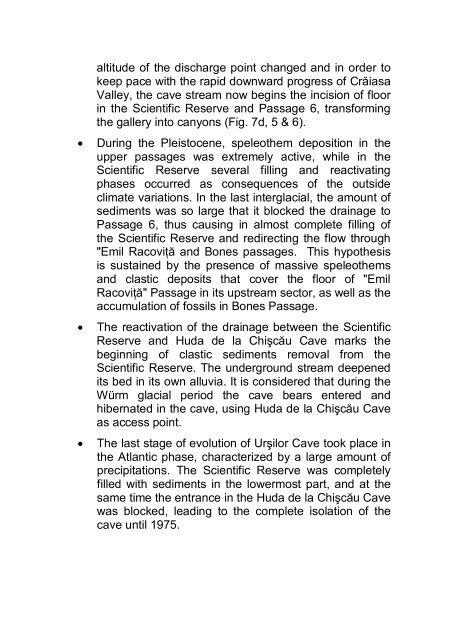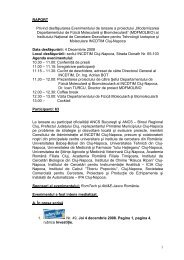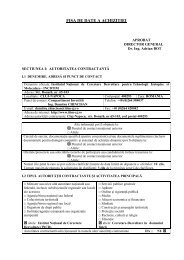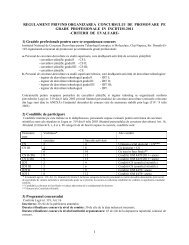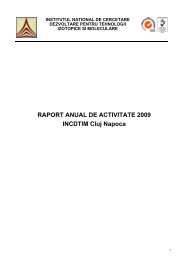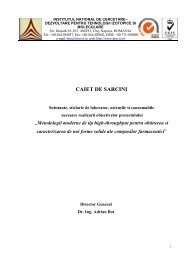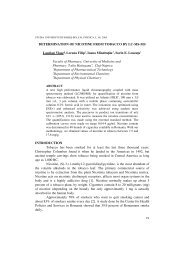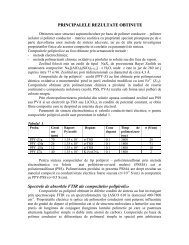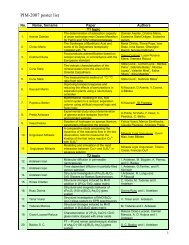Karst and caves in the Bihor Mountains - ITIM
Karst and caves in the Bihor Mountains - ITIM
Karst and caves in the Bihor Mountains - ITIM
- No tags were found...
You also want an ePaper? Increase the reach of your titles
YUMPU automatically turns print PDFs into web optimized ePapers that Google loves.
altitude of <strong>the</strong> discharge po<strong>in</strong>t changed <strong>and</strong> <strong>in</strong> order tokeep pace with <strong>the</strong> rapid downward progress of CrăiasaValley, <strong>the</strong> cave stream now beg<strong>in</strong>s <strong>the</strong> <strong>in</strong>cision of floor<strong>in</strong> <strong>the</strong> Scientific Reserve <strong>and</strong> Passage 6, transform<strong>in</strong>g<strong>the</strong> gallery <strong>in</strong>to canyons (Fig. 7d, 5 & 6).• Dur<strong>in</strong>g <strong>the</strong> Pleistocene, speleo<strong>the</strong>m deposition <strong>in</strong> <strong>the</strong>upper passages was extremely active, while <strong>in</strong> <strong>the</strong>Scientific Reserve several fill<strong>in</strong>g <strong>and</strong> reactivat<strong>in</strong>gphases occurred as consequences of <strong>the</strong> outsideclimate variations. In <strong>the</strong> last <strong>in</strong>terglacial, <strong>the</strong> amount ofsediments was so large that it blocked <strong>the</strong> dra<strong>in</strong>age toPassage 6, thus caus<strong>in</strong>g <strong>in</strong> almost complete fill<strong>in</strong>g of<strong>the</strong> Scientific Reserve <strong>and</strong> redirect<strong>in</strong>g <strong>the</strong> flow through"Emil Racoviţă <strong>and</strong> Bones passages. This hypo<strong>the</strong>sisis susta<strong>in</strong>ed by <strong>the</strong> presence of massive speleo<strong>the</strong>ms<strong>and</strong> clastic deposits that cover <strong>the</strong> floor of "EmilRacoviţă" Passage <strong>in</strong> its upstream sector, as well as <strong>the</strong>accumulation of fossils <strong>in</strong> Bones Passage.• The reactivation of <strong>the</strong> dra<strong>in</strong>age between <strong>the</strong> ScientificReserve <strong>and</strong> Huda de la Chişcău Cave marks <strong>the</strong>beg<strong>in</strong>n<strong>in</strong>g of clastic sediments removal from <strong>the</strong>Scientific Reserve. The underground stream deepenedits bed <strong>in</strong> its own alluvia. It is considered that dur<strong>in</strong>g <strong>the</strong>Würm glacial period <strong>the</strong> cave bears entered <strong>and</strong>hibernated <strong>in</strong> <strong>the</strong> cave, us<strong>in</strong>g Huda de la Chişcău Caveas access po<strong>in</strong>t.• The last stage of evolution of Urşilor Cave took place <strong>in</strong><strong>the</strong> Atlantic phase, characterized by a large amount ofprecipitations. The Scientific Reserve was completelyfilled with sediments <strong>in</strong> <strong>the</strong> lowermost part, <strong>and</strong> at <strong>the</strong>same time <strong>the</strong> entrance <strong>in</strong> <strong>the</strong> Huda de la Chişcău Cavewas blocked, lead<strong>in</strong>g to <strong>the</strong> complete isolation of <strong>the</strong>cave until 1975.


